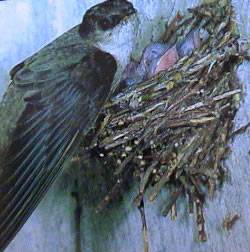Chimney swifts have been protected by federal law since 1918 with the passage of the Migratory Bird Treaty Act. Interestingly, since they migrate over the Canadian border, they were first covered by a treaty between the United States and Britain. Part of the Commonwealth, Canada’s interests were given British representation.

The removal of chimney swift nests is nothing to consider lightly, but consideration is necessitated by fire safety issues. The bottom line is you cannot move chimney swifts once they have nested. You have to wait until the young have left the nest, and then have a chimney sweep come and remove the nest and debris.
If – like most homeowners – you would not recognize a chimney swift if it were perched on your back porch, this whole situation gets complicated. You may be completely unaware just what a chimney swift nest even looks like. With a huge migratory path that spans the entire eastern half of North America, chimney swifts fly over lots of rooftops.
Furthermore, in other areas, other birds may have protected status, so the best bet is to call someone who knows which protected birds are local to your area. Conservation groups can provide this information, and so can the chimney sweeps that will have to deal with the aftermath of the nesting. The only sure fire way to keep animals of any kind from building a nest in your chimney is, of course, to have a chimney cap installed.
If your home is on the migratory path of chimney swifts, don’t bother trying to figure out whether the nest is one of theirs. The penalties are stiff, and installing a chimney cap is easier and cheaper anyway. Bottom line? Call The Mad Hatter, and have us perform an inspection. We will be able to give you timely advice to avoid the problem to begin with!
